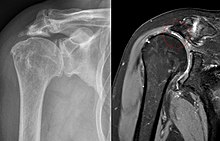Neo-joint

A neo-joint (also nearthrosis or nearthrosis) is a newly formed joint-like connection between two bones or pieces of bone that does not occur at this point in normal anatomy. The artificial creation of a joint-like bone contact and, in the broader sense of the word, joint prostheses are also referred to as neo-joints.
The term is sometimes not sharply separated from that of the false joint ( pseudarthrosis ), but it is usually used for the formation of a joint-like structure between two pieces of a bone after a fracture, while the neo-joint is also used to describe the connection between two different bones. In some works, the distinction is also made according to how much the new formation resembles a real joint , for example whether synovial fluid is present.
The cause of the non-artificial neo-joints can e.g. B. be an untreated dislocation , in which the dislocated bone comes into contact with bone again at a different point and a joint-like shape and possibly also function develops through the gradual reshaping of these two. Other causes can be the loss of anatomical structures due to trauma or degeneration , which normally lie between two bones and thus keep a distance between them. A frequently occurring example of this is the formation of a neo-joint between the humerus head and acromion after damage to the rotator cuff , especially the supraspinatus muscle .
Literature and individual references
- ↑ Nearthrosis at Rochelexikon online
- ↑ Nearthrose in Otto Dornblüth : Clinical Dictionary (13/14 Edition) (1927) at www.textlog.de
- ↑ Nearthrose in Meyers Encyclopedia in retro library
- ↑ KNKortmann: Results of the endoprosthetic shoulder joint replacement with a fourth generation prosthesis model - A prospective study - (PDF file; 9.5 MB) Dissertation 2008 at the Medical Faculty of the University of Münster